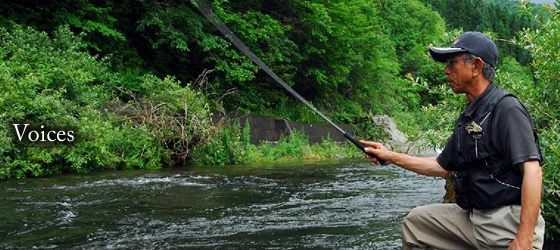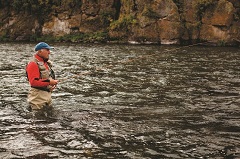証言2

Yvon Chouinard’s Articles 2
Simple Gifts
About 20 years ago I was given a 7 ½-foot three-weight cane rod
by the Japanese rod maker Naoki Hara.
I used the rod to catch a large, fine-spotted Snake River cutthroat,
took a photo of the fish lying next to the golden yellow bamboo rod
and sent it to the rod maker.
I then put the rod away in the closet for the next 15 years,
which I suspect is where most cane rods that are given to businessmen
for 25 years of loyalty with the firm end up.
More recently I read the book The Bamboo Fly Rod and saw
the excellent film Trout Grass.
Once I understood the passion and spirit that goes into
the making of these rods, I decided to start using that little
three-weight on spring creeks and high lakes and meadow creeks in
Wyoming, where I found the cane rod perfectly suitable,
especially when using a 6x or 7x tippet. Not only that, it had soul.
Last year I received the gift of another cane rod, a 12 ½-foot hollow spey rod
from Bob Clay in Kispiox, B.C. That’s nice of him, I thought.
But the last thing I needed was an old-fashioned bamboo spey rod.
The first time I tried a spey rod was 50 years ago on the Tweed in Scotland.
It was a bendy green heart rod. I thought these heavy, slow,
doubled-handed rods were almost prehistoric.
Bob and I walked down to the river below his house, where he attempted
to show me how to cast this slower, but surprisingly powerful, rod.
Being used to big, faster-action graphite rods, I was a slow learner.
Bob told me about his daughter Kateri winning a spey-casting contest at the
Golden Gate Casting Club using one of his rods.
Obviously there was nothing wrong with the rod; the problem was me.
I had developed a bunch of bad casting habits.
With graphite you can overpower the rod at the last second and correct
a multitude of bad moves.
I finally brought myself up to the rod’s potential and last year
caught many large steelhead, including one of 24 pounds,
which I landed even though the handle of my reel had fallen off.
I love good tools, but a tool should not replace skill.
Rather, a tool should allow one to maximize the joy and
contentment of manual labor.
Last year I fished the Sesia River in northern Italy,
with my friend and excellent fly fisherman, Mauro Mazzo.
He mentioned that the traditional way to fish this river is the same as
described by Dame Juliana Berner in her treatise written in 1496.
The technique is to use a rod 12- to 14-feet long with no reel and just
a horsehair-line tied to the tip. The lines, which are about one or
one-and-a-half times the length of the rod,
are braided from the tail of a white stallion, starting with 14 or 16 hairs
and tapering down to three at the tippet end.
A nylon leader is added, and one to five soft hackle flies are tied one foot apart.
Casting is done using various overhead, roll and spey casts.
It’s particularly effective in the winter for very wary and selective grayling.
A size 20, purple body soft hackle is used.
The hackles are made from very soft, lifelike feathers from a bird called a Cuiffolotto.
There are still about 20 practitioners of this technique in Italy, of which 10
still braid their own lines.
I remembered that 20 years ago, a Japanese friend had given me a fiberglass
telescoping rod – with no reel seat.
It was a beautiful, precious gift; light sensitive and elegant.
It’s called a tenkara rod, and is used in Japan,
to fish for Yamame trout in small mountain streams.
When I received this rod, I really didn’t understand what I was getting,
and I stored it on a shelf in my cabin for two decades.
Last summer Mauro and I decided to try out this tenkara/Valsesiana technique
on a willow-lined meadow creek in the Wyoming Range.
It was a super windy day in August, and grasshoppers were being blown about,
so we put on a muddler and fished it upstream as a
hopper and downstream as a sculpin.
The thin, heavier horsehair line cut through the wind far better
than a floating fly line.
Every bend of the creek had a pool, and we moved from pool to pool
without having to reel in line and let it out again.
We caught fish in every pool; nice cutthroats up to 16 inches.
I could see that a larger fish would be a problem to land. Supposedly
if you hook a large fish, you throw the rod in the river,
let it play out the fish and swim after it later!
Or you tie a retrieval cord onto the handle. Mauro’s girlfriend Danielle,
who had never fished a day in her life, picked up the rod and in less
than five casts landed the biggest cutthroat of the day.
“Easy,” she says. “What’s the big deal?” I think this centuries-old technique
was more perfect and effective for the job that day than anything that
has come out of our high-tech fly fishing industry.
In fact, I believe this is the same gear and technique traditionally used by
French market fishermen.
When your living is dependent on supplying restaurants and markets with trout,
you’re not going to waste your money on $500 reels, $700 rods and $3 flies.
I’ve continued to use the tenkara rod with great satisfaction and success.
One day in early September, on a riffle of the Firehole River in Yellowstone,
in the time it took my wife, sitting in the car, to read three L.A. Times newspapers,
I landed 35 browns and rainbows up to 14 inches.
Heaven knows we fly fishermen are suckers for every new gizmo we think
will give us a leg up on catching fish. We wear vests with 20 pockets, waders
with more storage, lanyards and waist- and backpacks
to carry even more impedimenta.
Dozens of fly lines are available to us, yet I seriously doubt you will catch
one more trout with a nymphing line than a classic double taper.
The no-nonsense fly fisherman from Terrace, B.C., Rob Brown,
looking over a steelheader’s array of fly boxes filled with hundreds of garish
flies said it best when he asked, “When did the green butt stop working for you?”
In these trying times, when we are seeing the result of our high-tech,
risky financial and highly toxic economic systems,
many of us are questioning our frenetic, consumer lifestyles.
We yearn for a simpler life based not on refusing all technology,
but going back to appropriate technology, what David Brower describes as
“turning around and taking a forward step.”
I would offer that proliferation of gear is supported by busy people who
lack nothing in their lives except time.
Their “time-saving” communication devices, like computers,
Blackberries and cell phones, have made slaves of their owners.
They are unwilling to put in the 10,000 hours needed to make themselves skillful fishermen,
hunters or mountain climbers.
Instead, they load up with all the latest stuff and hire guides to do everything for them,
including tying on the fly and releasing the fish so they don’t get slimed.
The guides have really become “enablers” rather than teachers.
How many bonefish would the average angler catch if they had to work out the tides
and wade and spot the fish themselves, instead of waiting for the micromanagement of
“10 o’clock, 40-foot cast now! Wait, strip, strip!”?
If you merely want to catch a lot of trout, replace that San Juan worm with a real worm.
Shoot a black bear?
Prop that scoped rifle on the handlebar of your ATV and shoot ‘em in the ass
when he tucks into that barrel of rotten whitefish and suckers.
Climb Mount Everest?
Hire a sherpa to pull and one to push, put on the oxygen mask and dial
in so much oxygen that it blows your hair backward.
But you know the Zen master would say you’ve blown it.
The higher purpose of practicing a sport like fly fishing,
hunting or mountain climbing, is to effect a spiritual and physical gain,
and if the process is compromised,
there is no transformation. My son started out hunting wild boar
in coastal California with a crossbow, then graduated to bows and arrows,
and then to using a homemade spear.
When that became too easy, he went to chasing them into the surf
and closing in with a knife to the base of the skull.
No dogs. I’ve been on a mission to simplify not only my rods,
but my fly selection.
For steelhead and Atlantic salmon, I’ve got it down to about 10 essential
flies each, but I’m sure I could be just as successful with five,
or maybe just a muddler for everything.
For the last couple of years I’ve been pushing the simplicity concept even further
by trout fishing almost exclusively with Sylvester Nemes’ soft hackles,
fishing them as nymphs, emergers and dries.
The result is catching probably more trout than I ever have.
The high point was fishing a high lake in the Wind River Mountains
of Wyoming and watching normally fickle golden trout come up from
20 feet down to smash size 22 red- bodied soft hackles at the surface.
I can think of lots of examples where the old ways of doing things have
not been surpassed by modern technology.
Consider the “green revolution” farmer in his air-conditioned tractor producing
inferior and even toxic food, and contrast that with the small organic farmer or
gardener finding contentment and pleasure in using his tools or walking behind
his perfectly trained plow horses or oxen.
The “green revolution,” dependent on non-sustainable chemical farming,
actually produces less food per acre, especially over time.
Compare the black and white photographs of Ansel Adams, Edward Weston
and Irving Penn, with color or digital.
It’s the difference between art and mere representation.
I have young friends who are surfing on replicas of 18th-century wooden
surfboards from the Bishop Museum in Hawaii.
They are thin and flat as an ironing board with no fin, yet they can ride them
better than 99% of the surfers on modern plastic boards.
The professional load carriers around the world all carry loads on
their heads – from African women with huge jars of water to sherpas
who carry double loads (110 pounds) with a tump line.
In fact, the United Nations has done a study proving that carrying
loads in this way is 50% more efficient than any high-tech, modern backpack.
I believe the way toward mastery of any endeavor is to work towards simplicity;
replace complex technology with knowledge, hard work and skill.
Consume less, consume better.
Try to purchase multi-functional gear.
Ask yourself if you would really catch more trout with a new $700 reel.
Fly fishing has gotten a reputation of being an elite sport where you stay at
expensive lodges, fish only private waters, and spend $600 per day for a guide.
No one wants to deal with teaching a kid such a complex sport, so the kids stay
glued to the TV and video games. It’s no wonder fly fishing is a dying sport.
I propose that you could hand a 10-year old kid or a one-armed war
veteran a tenkara rod and put them on a riffle with a wet fly and have them
catching fish on their own in minutes.
I don’t plan to give away my boron / graphite rods, skagit lines and high-tech
waterproof waders any time soon, but I am going to continue to see how far
I can go in simplifying my sports and my life. I may even have time to clean out
the shed one of these days.





















